The Eastern Tuna and Billfish Fishery is managed by limiting the catch of tuna and billfish species, restricting how many boats can fish and regulating what gear they can use.
The species caught in the fishery are also caught by many other countries. Australia’s catch of tuna and billfish is a very small part of the total catch internationally.
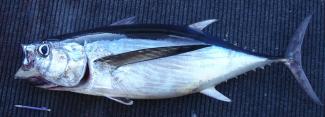
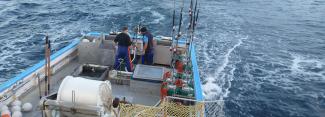
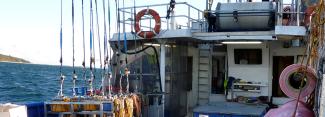
Target Species
| Species | Fishing Mortality* | Biomass** |
|---|---|---|
Thunnus alulunga | G;Not subject to overfishing | G;Not overfished |
Thunnus obesus | G;Not subject to overfishing | G;Not overfished |
Thunnus albacares | G;Not subject to overfishing | G;Not overfished |
Xiphias gladius | G;Not subject to overfishing | G;Not overfished |
Kajikia audax | Y;Uncertain | R;Overfished |
* Fishing mortality status relates to the level of fishing pressure on a stock - specifically, whether fishing mortality in the year being assessed is likely to result in the stock becoming overfished, or prevent the stock from rebuilding from an overfished state. If fishing mortality exceeds either of these thresholds, a stock is considered to be subject to overfishing.
** Biomass status relates to how many fish there are - specifically, whether the biomass in the year being assessed is above the level at which the risk to the stock is considered to be unacceptable. The HSP defines this level as the limit reference point, below which the stock is considered to be overfished.
Catch allowance
| Species | 2025 total allowable catch (tonnes) | 2024 total allowable catch (tonnes) | 2023 total allowable catch (tonnes) |
|---|---|---|---|
| Albacore tuna | 2,500 | 2,500 | 2,500 |
| Bigeye tuna | 1,056 | 1,056 | 1,056 |
| Broadbill swordfish | 1,047 | 1,047 | 1,047 |
| Striped marlin | 351 | 351 | 351 |
| Yellowfin tuna | 2,400 | 2,400 | 2,400 |
Download data on annual catch and effort from AFMA logbooks.
2025 ETBF Season TACCs and Conversion factors
| Quota species | 2025 total allowable catch (tonnes) | Total number of Statutory Fishing Rights | Conversion factors for the 2021 fishing season (kg per SFR) |
|---|---|---|---|
| Albacore Tuna | 2,500 | 1,076,026 | 2.32336393 |
| Bigeye Tuna | 1,056 | 1,076,026 | 0.98138893 |
| Broadbill Swordfish | 1,047 | 1,076,026 | 0.97302482 |
| Striped Marlin | 351 | 1,076,026 | 0.3262003 |
| Yellowfin tuna | 2,400 | 1,076,026 | 2.23042938 |
Total fishery value
$A40.1 million (2022–23).
Fishing gear
Longline and minor line (including handline, troll, rod and reel) fishing gear is used in this fishery.
Fishers mainly use longline fishing gear to catch the targeted species. These are very long lengths of fishing line with hooks that hang down and have bait attached. The longlines are set into the water near the surface and catch the fish individually.
Location
The Eastern Tuna and Billfish Fishery extends from Cape York in Queensland to the South Australian/Victorian border. Fishing occurs in both the Australian Fishing Zone and adjacent high seas.
Major landing ports
- Queensland
- Cairns
- Mooloolaba
- Southport
- New South Wales
- Coffs Harbour
- Ulladulla
- Bermagui
Markets supplied
- Domestic: fresh
- International: Japan, United States - mainly fresh, Europe - frozen, American Samoa, Indonesia, Thailand - albacore mainly for canning.
Fishing season
12-month season, beginning on 1 January.
Management of catch
This fishery is managed under a quota system that limits the amount of fish that boats can take in the fishery. This quota limit is also known as a total allowable commercial catch. Albacore tuna, bigeye tuna, yellowfin tuna, broadbill swordfish and striped marlin are all managed by quota in this fishery. Under this system, each fisher is limited to catching up to the amount of quota that they hold and the whole fishery is limited to the total allowable commercial catch that is set each season. Setting quotas is one of the main methods AFMA uses to ensure these fish species remain sustainable.
Each year the AFMA Commission decides on the allowable catch using information provided by the fishery manager, industry members and scientists. The Tropical Tuna Resource Assessment Group and the Tropical Tuna Management Advisory Committee recommend to the AFMA Commission what they think the allowable catch should be each season.
A number of sources are used to determine the quota figure. These include harvest strategies and species indicators such as catch and effort data in the fishery, environmental aspects, stock assessments for the main targeted species in the fishery and other available scientific information.
The total allowable commercial catch for each target species in this fishery is based on the largest amount of catch of a species that can be taken out of the ocean each year without causing a decline in the species survival over time (also known as maximum sustainable yield).
Eastern tuna and billfish species are also managed internationally. This means their stock status indicates the sustainability for the whole south west Pacific Ocean region. Operators in the Eastern Tuna and Billfish Fishery only catch a very small part of the total international catch.
International management
The tuna and billfish species caught in this fishery are highly migratory and swim over large distances and between different countries. For this reason, they are also managed internationally.
The Western and Central Pacific Fisheries Commission is made up of a large number of member countries, of which Australia is a leader. This Commission meets every year and reviews the catch, effort and scientific information for all countries that are members and discusses rules or management techniques to restrict catch or fishing effort across the Western and Central Pacific Ocean. AFMA has to consider any rules or management by the Western and Central Pacific Fisheries Commission when managing the Eastern Tuna and Billfish Fishery.
Licence to fish
To fish in this fishery, fishers need to hold statutory fishing rights allocated by AFMA.
Statutory fishing rights allow fishers to fish in the fishery and catch the fish species that are under a quota. The amount of rights an operator holds depends on the amount of quota they are allocated. The number of rights and the amount of quota changes every year.
Statutory fishing rights are transferable between fishers, they may also be known as individually transferable quotas.
In the fishery, there are currently:
- 79 longline boat statutory fishing rights
- 83 minor line boat statutory fishing rights
- 1 076 026 quota statutory fishing rights for each quota species
- 11 Coral Sea zone statutory fishing rights.
Collecting data
Data about the catch and effort of the fishery is collected from the logbooks fishers have to fill out for every longline fishing shot. Logbooks record:
- the species and amount caught
- the catch that is discarded
- the catch/release of any protected species and their life status
- the time and location of fishing activities
- the type and amount of gear used.
Fishery closures
Fishery closures is another way of managing catch in the fishery.
Currently, there are three closures in the Eastern Tuna and Billfish Fishery.
- Coral Sea – the Coral Sea zone is part of the Eastern Tuna and Billfish Fishery, but fishers must get a separate permit to fish in this area.
- Lord Howe Island – no fishing is allowed within 12 nm of Lord Howe Island.
- Norfolk Island – no fishing is allowed within the vicinity of Norfolk Island.
Species sustainability
The status of the eastern tuna and billfish stocks is assessed every three years by the Western and Central Pacific Fisheries Commission scientific committee, with contributions from Australian scientists from ABARES and CSIRO.
As albacore tuna, bigeye tuna, yellowfin tuna, broadbill swordfish and striped marlin are also caught by a number of other countries, they are assessed at a global level.
Species risk assessments
AFMA regularly monitor the effects fishing activities have on marine species, habitats and communities through ecological risk assessments. The assessment results help to prioritise the management, research, data collection and monitoring needs for the fishery.
After the risk assessment is complete, an ecological risk management strategy is developed to address how AFMA will manage marine species, habitats and communities identified in the assessment as greatly impacted by commercial fishing operations.
Read the most recent assessment and strategy for the Eastern Tuna and Billfish Fishery.
Bycatch work plans
A bycatch and discarding workplan outlines ways to minimise the bycatch of species that are at a high risk of being caught as bycatch in the fishery. These species can include threatened, endangered and protected species, sharks and other non-target fish species.
The Eastern Tuna and Billfish Fishery’s approach for managing bycatch and discards is outlined in the ETBF Fishery Management Strategy 2019-2023.
Commercial species management
A commercial species strategy is used to help determine what the quota should be for the target species in the fishery. Fishing, environmental and economic information is included in the strategy, which helps to monitor and maintain the sustainability of the targeted species.
The commercial species strategy is developed in line with the Commonwealth Fisheries Harvest Strategy Policy and Guidelines.
Read the commercial species strategy in the ETBF Fishery Management Strategy 2019-2023.
Harvest strategy
A harvest strategy is used to help determine what the quota should be for the target species of the fishery. Fishing, environmental and economic information is included in the harvest strategy, which helps to monitor and maintain the sustainability of the targeted species.
All harvest strategies are developed in line with the Commonwealth Fisheries Harvest Strategy Policy and Guidelines.
Read the Australian Tuna and Billfish Fishery Harvest Strategy.
Export approval
To export from an Australian commercial fishery, the fishery must be approved as a wildlife trade operation by the Department of Climate Change, Energy, the Environment and Water under the Environment Protection and Biodiversity Conservation Act 1999 (EPBC Act).
In May 2022, AFMA submitted an application for the Commonwealth Eastern Tuna and Billfish Fishery (the fishery) to the Department for assessment as an approved wildlife trade operation under the EPBC Act. Following assessment, the fishery has been approved as wildlife trade operation for three years, until 19 August 2025.
Read the details of the Eastern Tuna and Billfish Fishery wildlife trade approval and conditions.
Marine reserves
Commonwealth marine reserves are areas established under Australian environment law to help conserve the spectacular marine life in our oceans. They allow ecologically sustainable use of our marine resources and provide special places for people to enjoy and appreciate the fantastic diversity of our marine habitats.
Marine reserves are sometimes known as marine protected areas or marine parks and are managed by the Department of Climate Change, Energy, the Environment and Water.
More information about marine reserves can be found on the Department of Climate Change, Energy, the Environment and Water website.
Fishing in the fishery
Fishing operators wanting to fish in the Eastern Tuna and Billfish Fishery must hold quota statutory fishing rights and a boat statutory fishing right.
See the Eastern Tuna and Billfish Fishery Management Arrangements Booklet 2025 for a full description of all fishing requirements in the fishery.
Fishery legislation
The management of the Eastern Tuna and Billfish Fishery is also governed by legislation.
Management plan – The Eastern Tuna and Billfish Fishery Management Plan 2010 came into effect on 1 March 2011.
Total allowable commercial catch Determination – The Eastern Tuna and Billfish Fishery (Fishing Season and Total Allowable Commercial Catch) Determination (No.2) 2024 sets the total allowable commercial catch limits for each fishing season. These limits are decided by the AFMA Commission.
Overcatch and undercatch Determination – The Eastern Tuna and Billfish Fishery Overcatch and Undercatch Determination 2024 sets out the amounts and percentages for each quota species in relation to undercatch and overcatch for each fishing season.
Fishing industry
Each fishing season, AFMA officers visit the major fishing ports of the Eastern Tuna and Billfish Fishery. These visits allow AFMA and fishers to meet directly to discuss any concerns. Discussions about the current trends in fishing and catches during the season are also valuable information gained on these visits. All this information is useful for the continuing management of the fishery.
Tropical Tuna Management Advisory Committee
The Tropical Tuna Management Advisory Committee is the advisory body for the Eastern Tuna and Billfish Fishery. The committee includes representatives from AFMA, industry, scientific agencies, environmental non-government organisations, the recreational/charter fishing sector and state government. Two meetings are held each year to discuss any problems relating to this fishery, review scientific information and develop possible management measures.
See the Tropical Tuna Management Advisory Committee webpage for a summary of the latest discussions and outcomes from the committee.
Tropical Tuna Resource Assessment Group
The Tropical Tuna Resource Assessment Group provides research and scientific advice for the fishery. The group is composed of fishery scientists, fishing industry members, an economist, an AFMA representative and recreational representatives.
See the Tropical Tuna Resource Assessment Group webpage for a summary of the latest discussions and outcomes from the group.
Recreational fishers
Many of the fish species caught by commercial fishers in the Eastern Tuna and Billfish Fishery are also caught by recreational fishers. The recreational fishing of these species is managed by the NSW and Queensland state governments.
Download list of NSW game fishing offshore events for 2023.
Government departments
AFMA works closely with other government departments, such as the Department of Agriculture, Fisheries and Forestry and the Department of Climate Change, Energy, the Environment and Water. They help in providing advice and guidance on both domestic and international fisheries issues.
State governments
The Australian state governments manage fishing from the Australian coast out to 3 nm. Occasionally there is some overlap in fishing operations between the state and commonwealth jurisdictions and AFMA regularly communicates with the state fisheries agencies to manage any problems.
Representatives from the state fisheries agencies also attend the Tropical Tuna Management Advisory Committee meetings and provide input and advice.
Environmental non-government organisations
Representatives from environmental non-government organisations attend the Tropical Tuna Management Advisory Committee meetings and provide input and advice.
International organisations
Australia catches several migratory species such as tuna and billfish. These species are also caught by other countries. There are several regional fisheries management organisations that look after these migratory fish species and Australia works closely with these organisations when managing our fisheries.
Management publications
Eastern Tuna and Billfish Fishery – management arrangements booklet
Eastern Tuna and Billfish Fishery Management Plan 2010
Eastern Tuna and Billfish Fishery Management Strategy
Eastern Tuna and Billfish Fishery TACC setting procedure
Environment publications
Ecological risk management reports
Climate and Ecosystem Status Report (PDF, 3.7 MB)
Research and data publications
Eastern Tuna and Western Tuna Billfish Fisheries Strategic Research Plan 2023–2028
Calculation of Broadbill Swordfish Recommended Biological Commercial Catch in 2025
ABARES logbook and EM data congruence analysis 2023 (PDF, 12 MB)
Management Strategy Evaluation for Striped Marlin
Evaluation of proposed modification to Swordfish Harvest Strategy
Modified swordfish harvest strategy
Calculation of Broadbill Swordfish Recommended Biological Commercial Catch in 2023
Calculation of Broadbill Swordfish Recommended Biological Commercial Catch in 2022
Tools
Maps
There are several maps that are relevant to the Eastern Tuna and Billfish Fishery. The first map below shows the sea area that is included in the fishery.
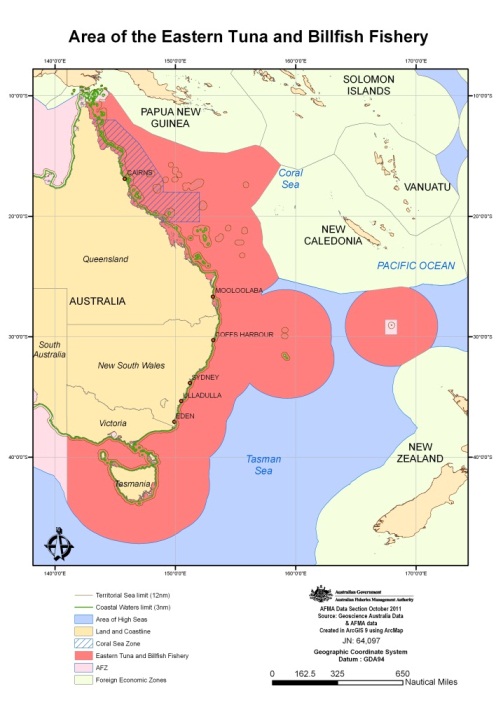
Between May and October, the waters off NSW and Victoria are cooler and Southern Bluefin Tuna migrate through these areas. To manage the catch of southern bluefin tuna, AFMA puts specific zones in place, which are reviewed weekly. For the current map of the southern bluefin tuna management zones, please see the map located on the SBT Zone page.
The Eastern Tuna and Billfish Fishery is also part of the Western and Central Pacific Fisheries Commission (WCPFC). The Australian fishery in relation to the WCPFC Area of Competence is displayed below.
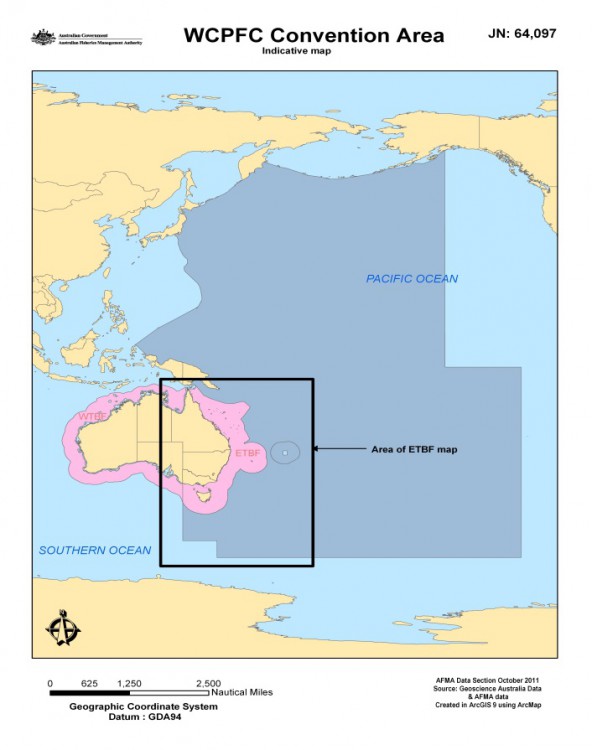
Cameras on fishing boats – electronic monitoring
AFMA has electronic monitoring systems on all fishing boats in the ETBF. These systems have sensors linked to surveillance cameras that record fishing activity, including the catch. These recordings can then be collected and monitored by AFMA. Electronic monitoring helps support monitoring and data collection.
Onboard observers
The AFMA Observer program is able to collect data through on-board observers and port sampling to provide fisheries managers, research organisations, environmental agencies, the fishing industry and the wider community with independent, reliable, verified and accurate information on the fishing catch, effort and practice of Commonwealth vessels.
The data contributes to biological and fishery operation data to key scientific assessments and assist monitoring of protected species interactions, amongst other uses.
The requirement to carry an observer in the ETBF, if requested by AFMA, is still contained in permit conditions however the e-monitoring program has largely replaced the AFMA Observer Program.
Further information about the AFMA Observer Program can be found here.
Satellite tracking
A satellite monitoring system called a Vessel Monitoring System (VMS), is fitted to every boat in the fishery. This system helps AFMA to monitor vessel position, course and speed. The tracking unit regularly transmits the information through a communications satellite to a station on land. This information is sent by secure internet connection to a database at AFMA.
Read more about our satellite tracking program.
Compliance
AFMA fisheries officers regularly inspect fishing boats and fish receivers. They often visit fishing ports and board boats at sea to try to ensure the rules of fishing are being followed.
For more information on AFMA’s compliance program, please see the Domestic Compliance webpage.